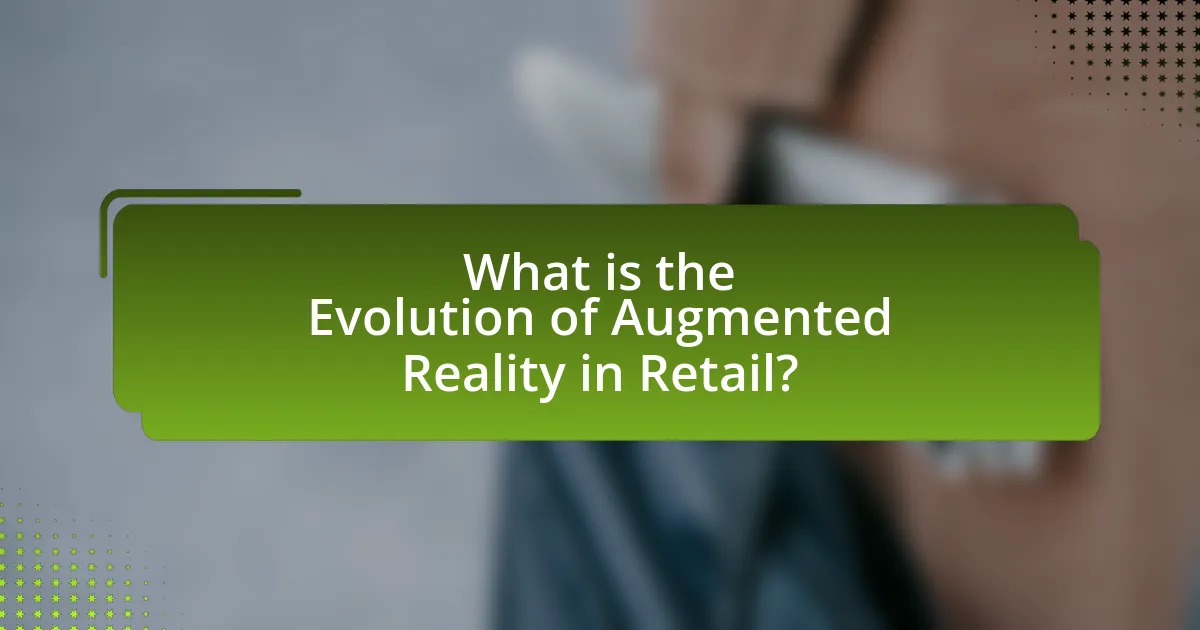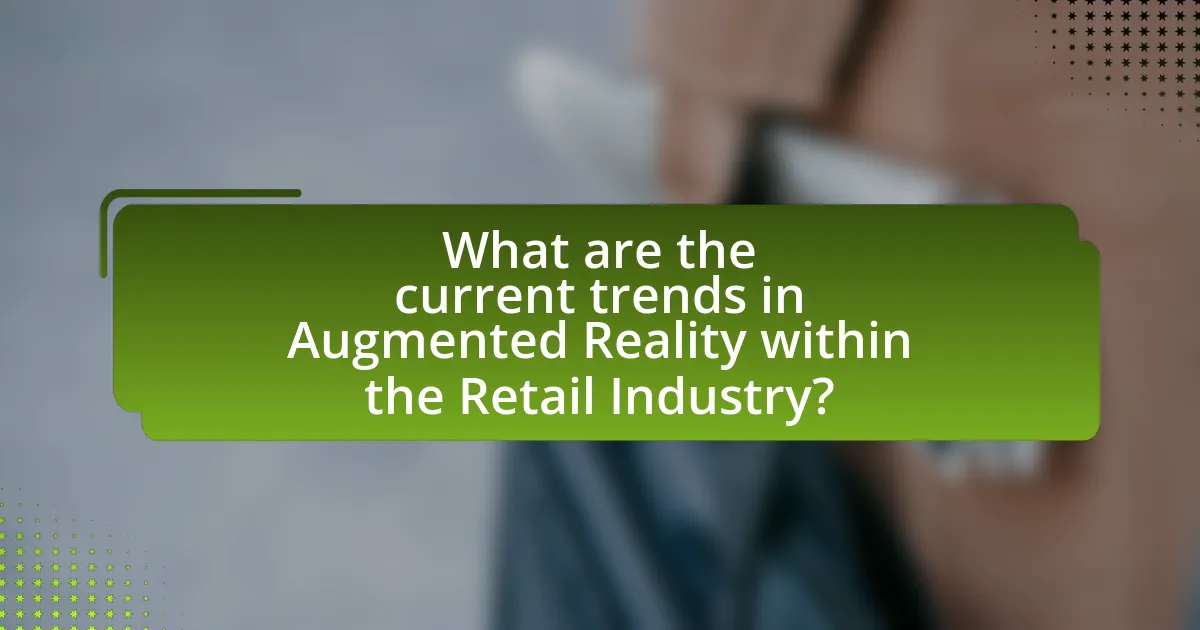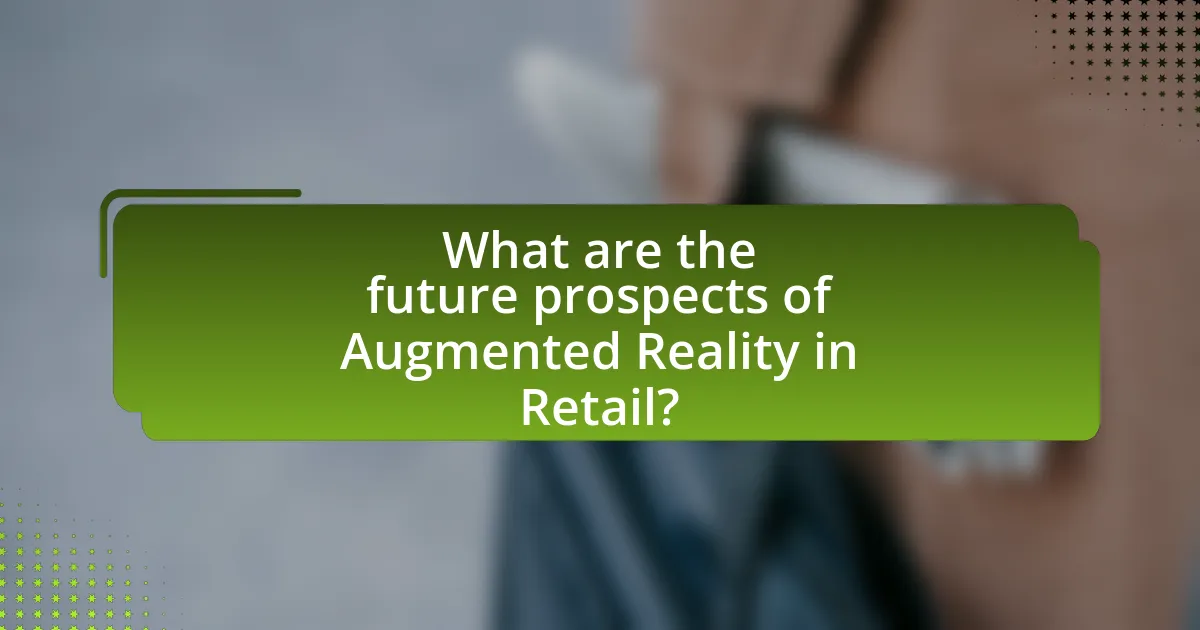The article focuses on the evolution of augmented reality (AR) in the retail sector, highlighting its transformative impact on the shopping experience. It outlines the progression from basic AR applications to advanced solutions that enhance customer engagement, such as virtual try-ons and interactive displays. Key milestones in AR development, changing consumer expectations, and the importance of AR for retailers are discussed, along with current trends and challenges faced in implementation. The article also explores future prospects for AR in retail, emphasizing innovations and best practices that can enhance customer engagement and drive sales.

What is the Evolution of Augmented Reality in Retail?
The evolution of augmented reality (AR) in retail has transformed the shopping experience by integrating digital elements into the physical environment. Initially, AR in retail was limited to simple applications, such as virtual try-ons and basic product visualizations, which began gaining traction in the early 2010s. As technology advanced, retailers adopted more sophisticated AR solutions, such as interactive displays and mobile applications that allow customers to visualize products in their own space, enhancing engagement and decision-making.
For instance, IKEA launched its AR app, IKEA Place, in 2017, enabling customers to see how furniture would look in their homes before purchasing. This application significantly improved customer satisfaction and reduced return rates, demonstrating the effectiveness of AR in retail. According to a 2021 report by Deloitte, 88% of consumers expressed a preference for retailers that offer AR experiences, highlighting the growing importance of this technology in the industry.
Overall, the evolution of AR in retail reflects a shift towards more immersive and personalized shopping experiences, driven by advancements in mobile technology and consumer demand for innovative solutions.
How has augmented reality transformed the retail landscape?
Augmented reality (AR) has transformed the retail landscape by enhancing customer engagement and improving the shopping experience. Retailers now utilize AR technology to allow customers to visualize products in their own environment before making a purchase, which has been shown to increase conversion rates. For instance, a study by Deloitte found that retailers using AR saw a 40% increase in conversion rates compared to those that did not. Additionally, AR applications enable virtual try-ons for clothing and accessories, reducing return rates and increasing customer satisfaction. This integration of AR into retail not only streamlines the purchasing process but also fosters a more interactive and personalized shopping experience.
What are the key milestones in the development of augmented reality for retail?
The key milestones in the development of augmented reality (AR) for retail include the introduction of AR applications in the early 2000s, the launch of the first AR-enabled mobile apps in 2009, and the widespread adoption of AR by major retailers like IKEA and Sephora in the 2010s. In 2012, IKEA released its AR catalog, allowing customers to visualize furniture in their homes, marking a significant shift in consumer engagement. By 2016, Pokémon GO demonstrated the potential of AR in driving foot traffic to retail locations, influencing retailers to explore similar technologies. The integration of AR with e-commerce platforms has continued to evolve, with advancements in smartphone technology and AR glasses enhancing user experiences. These milestones collectively illustrate the rapid growth and transformative impact of AR in the retail sector.
How have consumer expectations changed with the introduction of augmented reality?
Consumer expectations have significantly evolved with the introduction of augmented reality (AR) in retail, leading to a demand for more immersive and interactive shopping experiences. Shoppers now anticipate the ability to visualize products in their own environments before making a purchase, which enhances decision-making and reduces return rates. For instance, a study by Deloitte found that 40% of consumers are willing to pay more for a product if they can experience it through AR, indicating a shift towards valuing enhanced engagement and personalization in the shopping process. This change reflects a broader trend where consumers expect technology to bridge the gap between online and in-store experiences, ultimately influencing their purchasing behavior and brand loyalty.
Why is augmented reality important for retailers today?
Augmented reality is important for retailers today because it enhances customer engagement and improves the shopping experience. By allowing customers to visualize products in their own environment before making a purchase, retailers can increase conversion rates and reduce return rates. For instance, a study by Deloitte found that 88% of consumers prefer retailers that offer augmented reality experiences, indicating a strong preference for interactive shopping. Additionally, augmented reality can provide personalized recommendations and immersive experiences, which can lead to higher customer satisfaction and loyalty.
What advantages does augmented reality provide to retail businesses?
Augmented reality provides retail businesses with enhanced customer engagement and improved shopping experiences. By allowing customers to visualize products in their own environment, augmented reality increases the likelihood of purchase; for instance, a study by Deloitte found that 40% of consumers are willing to pay more for a product if they can experience it through augmented reality. Additionally, augmented reality can reduce return rates by helping customers make more informed decisions, as evidenced by a report from the National Retail Federation, which indicated that retailers using augmented reality saw a 30% decrease in product returns.
How does augmented reality enhance the shopping experience for consumers?
Augmented reality enhances the shopping experience for consumers by providing interactive and immersive product visualization. This technology allows shoppers to visualize products in their own environment before making a purchase, leading to increased confidence in buying decisions. For instance, a study by Deloitte found that 40% of consumers are willing to pay more for a product if they can experience it through augmented reality. Additionally, AR applications can facilitate personalized shopping experiences, enabling consumers to try on clothing virtually or see how furniture fits in their homes, which significantly reduces the likelihood of returns.

What are the current trends in Augmented Reality within the Retail Industry?
Current trends in Augmented Reality (AR) within the retail industry include the integration of virtual try-on solutions, enhanced in-store experiences, and personalized marketing strategies. Retailers are increasingly adopting AR technology to allow customers to visualize products in their own environment before making a purchase, which has been shown to increase conversion rates. For instance, a study by Deloitte found that 40% of consumers are willing to pay more for a product if they can experience it through AR. Additionally, brands like IKEA and Sephora have successfully implemented AR applications that enable users to see how furniture fits in their homes or how makeup looks on their skin, respectively. These trends indicate a significant shift towards immersive shopping experiences that leverage AR to enhance customer engagement and satisfaction.
How are retailers currently implementing augmented reality technologies?
Retailers are currently implementing augmented reality (AR) technologies by integrating virtual try-on solutions, interactive product displays, and immersive shopping experiences. For instance, companies like IKEA use AR to allow customers to visualize furniture in their own homes through mobile applications, enhancing decision-making and reducing return rates. Additionally, brands such as Sephora offer virtual makeup try-ons, enabling customers to see how products look on their skin before purchasing. These implementations are supported by data indicating that AR can increase customer engagement and conversion rates, with studies showing that 61% of consumers prefer retailers that offer AR experiences.
What types of augmented reality applications are most popular in retail?
The most popular types of augmented reality applications in retail include virtual try-ons, interactive product displays, and location-based experiences. Virtual try-ons allow customers to visualize how clothing, accessories, or makeup will look on them before making a purchase, enhancing the shopping experience and reducing return rates. Interactive product displays enable customers to engage with products through their smartphones or AR devices, providing additional information and immersive experiences. Location-based experiences use AR to guide customers through stores or provide contextual information about products, improving navigation and engagement. These applications have been shown to increase customer satisfaction and sales, with studies indicating that retailers using AR can see a significant boost in conversion rates.
How do different retail sectors utilize augmented reality differently?
Different retail sectors utilize augmented reality (AR) in distinct ways to enhance customer experience and drive sales. In the fashion retail sector, AR allows customers to virtually try on clothing and accessories through apps, improving fit and style decisions; for example, brands like Zara and ASOS have implemented AR fitting rooms that increase customer engagement and reduce return rates. In the furniture sector, companies like IKEA use AR to enable customers to visualize how furniture will look in their homes, facilitating informed purchasing decisions and reducing buyer’s remorse. The beauty industry leverages AR for virtual makeup try-ons, with brands like L’Oréal offering apps that allow users to see how products will appear on their skin, thus enhancing customer confidence in their purchases. Each sector tailors AR applications to meet specific consumer needs, demonstrating the versatility and effectiveness of augmented reality in retail.
What challenges do retailers face when adopting augmented reality?
Retailers face several challenges when adopting augmented reality, including high implementation costs, technological limitations, and consumer acceptance issues. High implementation costs can deter retailers, as developing AR applications and integrating them into existing systems often requires significant financial investment. Technological limitations, such as the need for advanced hardware and software, can also pose obstacles, as not all retailers have access to the necessary infrastructure. Additionally, consumer acceptance issues arise when customers are unfamiliar with AR technology or skeptical about its benefits, which can hinder widespread adoption. According to a report by Deloitte, 70% of consumers are interested in AR experiences, but only 20% have used them, highlighting the gap between interest and actual usage.
What technological barriers exist for retailers implementing augmented reality?
Retailers face several technological barriers when implementing augmented reality (AR), including high development costs, limited hardware compatibility, and insufficient infrastructure. High development costs arise from the need for specialized software and skilled personnel to create AR experiences, which can deter smaller retailers. Limited hardware compatibility restricts the effectiveness of AR applications, as not all consumers possess devices capable of supporting advanced AR features. Additionally, insufficient infrastructure, such as slow internet connectivity and lack of robust mobile networks, can hinder the seamless integration of AR into retail environments. These barriers collectively impede the widespread adoption of AR technologies in the retail sector.
How do consumer privacy concerns impact the use of augmented reality in retail?
Consumer privacy concerns significantly hinder the adoption of augmented reality (AR) in retail by creating apprehension among shoppers regarding data collection and usage. Retailers implementing AR technologies often require access to personal data, such as location and shopping habits, which can lead to distrust if consumers feel their information is not adequately protected. A survey by the International Association of Privacy Professionals found that 79% of consumers expressed concerns about how their data is used, which directly influences their willingness to engage with AR experiences. Consequently, retailers may face challenges in effectively deploying AR solutions, as they must balance innovative customer experiences with stringent privacy measures to build trust and encourage participation.

What are the future prospects of Augmented Reality in Retail?
The future prospects of Augmented Reality (AR) in retail are highly promising, with expected growth driven by enhanced customer experiences and operational efficiencies. According to a report by Statista, the AR market in retail is projected to reach $1.6 billion by 2025, indicating a significant increase in adoption. Retailers are increasingly utilizing AR for virtual try-ons, interactive displays, and personalized shopping experiences, which have been shown to increase customer engagement and conversion rates. For instance, a study by Deloitte found that 40% of consumers are willing to pay more for a product if they can experience it through AR. This trend suggests that AR will become a critical tool for retailers aiming to differentiate themselves in a competitive market.
How is augmented reality expected to evolve in the retail sector?
Augmented reality is expected to evolve in the retail sector by enhancing customer engagement and personalizing shopping experiences. Retailers are increasingly adopting AR technologies to allow customers to visualize products in their own environments before making a purchase, which can lead to higher conversion rates. For instance, a study by Deloitte found that 40% of consumers are willing to pay more for a product if they can experience it through AR. Additionally, AR is anticipated to integrate with artificial intelligence to provide tailored recommendations based on customer preferences and behaviors, further driving sales and customer satisfaction.
What innovations are on the horizon for augmented reality in retail?
Innovations on the horizon for augmented reality in retail include enhanced virtual try-on experiences, interactive in-store navigation, and personalized shopping assistance. Enhanced virtual try-on technology allows customers to visualize products on themselves in real-time, significantly improving the online shopping experience; for instance, companies like Warby Parker and Sephora have successfully implemented this feature. Interactive in-store navigation utilizes AR to guide customers through physical stores, helping them locate products efficiently, as seen in initiatives by retailers like IKEA. Personalized shopping assistance through AR applications can analyze customer preferences and provide tailored recommendations, a trend supported by advancements in AI and machine learning. These innovations are expected to transform customer engagement and streamline the shopping process in retail environments.
How might augmented reality change consumer behavior in the future?
Augmented reality (AR) is likely to significantly change consumer behavior in the future by enhancing the shopping experience through immersive interactions. AR technology allows consumers to visualize products in their own environment before making a purchase, which can lead to increased confidence in buying decisions. For instance, a study by Deloitte found that 40% of consumers are willing to pay more for a product if they can experience it through AR. This capability not only boosts sales but also reduces return rates, as customers have a clearer understanding of what they are purchasing. Furthermore, AR can facilitate personalized marketing, allowing brands to tailor experiences based on individual preferences, thereby increasing engagement and loyalty.
What best practices should retailers follow when integrating augmented reality?
Retailers should prioritize user experience, ensuring that augmented reality (AR) applications are intuitive and enhance customer engagement. A seamless integration of AR into the shopping experience can lead to increased customer satisfaction and higher conversion rates. For instance, a study by Deloitte found that 88% of consumers prefer retailers that offer AR experiences, indicating a strong preference for interactive shopping. Additionally, retailers should focus on high-quality content and realistic visuals, as research from the Journal of Retailing shows that immersive AR experiences can boost purchase intent by up to 40%. Finally, continuous testing and feedback collection are essential to refine AR applications, as evidenced by companies like IKEA, which regularly updates its AR features based on user input to improve functionality and appeal.
How can retailers effectively measure the success of augmented reality initiatives?
Retailers can effectively measure the success of augmented reality initiatives by analyzing key performance indicators (KPIs) such as user engagement, conversion rates, and customer feedback. User engagement can be tracked through metrics like time spent in the AR experience and interaction rates, which provide insights into how compelling the AR content is. Conversion rates, which reflect the percentage of users who make a purchase after engaging with AR, serve as a direct measure of the initiative’s impact on sales. Additionally, gathering customer feedback through surveys and reviews helps retailers understand user satisfaction and areas for improvement. Research indicates that AR can increase conversion rates by up to 40%, demonstrating its potential effectiveness in driving sales.
What strategies can enhance customer engagement through augmented reality?
Implementing interactive experiences is a key strategy to enhance customer engagement through augmented reality. By allowing customers to visualize products in their own environment, retailers can create a more immersive shopping experience. For instance, IKEA’s AR app enables users to place virtual furniture in their homes, leading to a 200% increase in customer engagement and a 30% higher conversion rate. Additionally, gamification elements, such as AR scavenger hunts, can further captivate customers, as evidenced by the success of Pokémon GO, which increased foot traffic to participating stores by 20%. These strategies leverage augmented reality’s capabilities to foster deeper connections between customers and brands, ultimately driving sales and loyalty.



